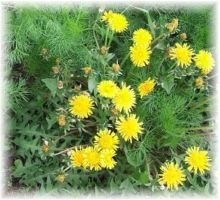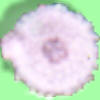CLICK: Color Control Color Choice

What brilliantly once shone in our locks as we four year old naturalists made "daisy chains" to celebrate the time of our lives (and that of the silken, new earth) is one of the most stable and versatile herbs to be found readily by almost anyone.
 The Dandelion, a
wildflower which is actually grown for Herb medicines, like Swedish Bitters,
and for wine, is often considered an annoying weed which commonly springs up
all over the lawn, its huge and tough long roots making it a hard weed to
remove from the flowerbed. It has been an official drug in pharmacopoeias
since the 16th century, first showing as Herba Taraxacom or
Herba Urinaria, because it is a diuretic, among
its wondrous properties.
The Dandelion, a
wildflower which is actually grown for Herb medicines, like Swedish Bitters,
and for wine, is often considered an annoying weed which commonly springs up
all over the lawn, its huge and tough long roots making it a hard weed to
remove from the flowerbed. It has been an official drug in pharmacopoeias
since the 16th century, first showing as Herba Taraxacom or
Herba Urinaria, because it is a diuretic, among
its wondrous properties.
 Most people know that the Dandelion found its
common name from its ' floral properties, a head full of scented and
toothed-tip yellow petals , and toothed leaf shapes, hence the French name
"Dents de Lion" and the latin, "Denta Leonis". We "northdays" types had better
keep up with the Russians - not to be outdone by tropical countries as we are,
the Russian Dandelion (T. kok-saghyz Rodin
) was cultivated in Russia as early as during
the Second World War as a source of latex. Hmmm-what could we do with our
dandelions and also our Milkweed? I have watched the Rabbit use latex from its
diet of dandelions effectively as a pain killer, its body choosing to arrest
the pain sensors by binding them with a soft, internal latex. Personally, I
employ "internal bandaids" in my self-care, and often stop bleeding from torn
areas by imagining a sort of blue tube which travels down the blood vessel and
stops the leak. It works, it works.
Most people know that the Dandelion found its
common name from its ' floral properties, a head full of scented and
toothed-tip yellow petals , and toothed leaf shapes, hence the French name
"Dents de Lion" and the latin, "Denta Leonis". We "northdays" types had better
keep up with the Russians - not to be outdone by tropical countries as we are,
the Russian Dandelion (T. kok-saghyz Rodin
) was cultivated in Russia as early as during
the Second World War as a source of latex. Hmmm-what could we do with our
dandelions and also our Milkweed? I have watched the Rabbit use latex from its
diet of dandelions effectively as a pain killer, its body choosing to arrest
the pain sensors by binding them with a soft, internal latex. Personally, I
employ "internal bandaids" in my self-care, and often stop bleeding from torn
areas by imagining a sort of blue tube which travels down the blood vessel and
stops the leak. It works, it works.
 Perhaps meditation on
Dandelion for temporary pain killer might lead to something efficient in
medicine. Like a lot of country-poor people I have found myself quite rich in
natural resources and I have actually relied on my lawn as a source of
sustenance. As a poor student, I claimed small and tender Dandelion leaves
from my lawn, along with new asparagus tips and fiddleheads from the
side of the house as salad or greens for the few days I was out of cash. I
remeber dashing about with a culender in hand, praising the Lord since I was
able to find so many types of nutrient in my early garden.
Perhaps meditation on
Dandelion for temporary pain killer might lead to something efficient in
medicine. Like a lot of country-poor people I have found myself quite rich in
natural resources and I have actually relied on my lawn as a source of
sustenance. As a poor student, I claimed small and tender Dandelion leaves
from my lawn, along with new asparagus tips and fiddleheads from the
side of the house as salad or greens for the few days I was out of cash. I
remeber dashing about with a culender in hand, praising the Lord since I was
able to find so many types of nutrient in my early garden.
 Plantain leaves are
another early green, like the Dandelion you can eat them raw or cook them like
spinach. I like young Dandelion leaves raw, and Plantain is gorgeous whether
cooked or raw. When raw, I mix them in walnut oil and Balsamic or apple cider
vinegar with a good many canteloupe balls and some walnuts. Of course, if you
are out in the wild and hope to survive on just the greens,they are not really
that palatable unless boiled. If you are eating fiddleheads (Ostrich fern
babies, which are curled in a tight spiral before they "bloom" as leaves) you
must boil the heads in three changes of water, taking care to remove all of
the brown, bitter papery chaff from the outside of the fiddlehead, because of
the dangers of stomach cancer.
Plantain leaves are
another early green, like the Dandelion you can eat them raw or cook them like
spinach. I like young Dandelion leaves raw, and Plantain is gorgeous whether
cooked or raw. When raw, I mix them in walnut oil and Balsamic or apple cider
vinegar with a good many canteloupe balls and some walnuts. Of course, if you
are out in the wild and hope to survive on just the greens,they are not really
that palatable unless boiled. If you are eating fiddleheads (Ostrich fern
babies, which are curled in a tight spiral before they "bloom" as leaves) you
must boil the heads in three changes of water, taking care to remove all of
the brown, bitter papery chaff from the outside of the fiddlehead, because of
the dangers of stomach cancer.
 As a matter of fact, give me
Dandelion any day as a versatile herb. Its' root will give you a type of
coffee when roasted and ground. It tastes like coffee with a slight bitterness
and sweetness added, or coffee with less carmel undertones. Perfectly benign
as a drink, Dandelion coffee used to be my choice in my days of pure food diet
and natural source nutrients. It was delicious, but I always had terrible gas
from Dandelion coffee, so I would imagine adding Beano to the original grind
would help immensely.
As a matter of fact, give me
Dandelion any day as a versatile herb. Its' root will give you a type of
coffee when roasted and ground. It tastes like coffee with a slight bitterness
and sweetness added, or coffee with less carmel undertones. Perfectly benign
as a drink, Dandelion coffee used to be my choice in my days of pure food diet
and natural source nutrients. It was delicious, but I always had terrible gas
from Dandelion coffee, so I would imagine adding Beano to the original grind
would help immensely.
 A few
years ago I received a newsletter from our "Hort Society"(The Carleton Place
Horticultural Society) which offered the recipe for Dandelion syrup. I tried
the recipe, rescuing four hundred heads away from imminent death by the sword
and putting them to good use in my syrup. I modified mine with a fruit, and
found the taste to be absolutely delicious. Below is the modified recipe. (You
just can't have too much of this tonic and tasty syrup!!)
A few
years ago I received a newsletter from our "Hort Society"(The Carleton Place
Horticultural Society) which offered the recipe for Dandelion syrup. I tried
the recipe, rescuing four hundred heads away from imminent death by the sword
and putting them to good use in my syrup. I modified mine with a fruit, and
found the taste to be absolutely delicious. Below is the modified recipe. (You
just can't have too much of this tonic and tasty syrup!!)
 RECIPE FOR DANDELION SYRUP ("LIMEY
SYRUP")
RECIPE FOR DANDELION SYRUP ("LIMEY
SYRUP")Pick about four hundred Dandelion flower heads. Wash them thoroughly in cool water, a couple of times. Cover the heads in a large saucepan, bring them to a boil, and continue to boil them for at least twenty minutes. Properly strain the heads from the Dandelion liquor by placing a cheesecloth or large coffee filter in a culender, and straining the floral shreds out. To the yellow Dandy liquor, add six cups of white sugar, plus (my innovation) two halves of a fresh lime fruit. Stir continuously on medium heat until the syrup forms. The way to test syrup is to produce a ribbon effect in cool water, or the syrup should slightly harden into a wiggling line without becoming a hard or even soft ball in the cool water.The ribbon of candy is formed and does not dissolve right away. This makes Dandelion syrup the consistency of Maple syrup. You can make more of a treacle if desired. Just evaporate more of the water through repeated stirring and boiling. When the syrup is ready, remove the candied lime (hey, eat it-chop it up for candied peel!) then pour the syrup into jars you have kept steamed in a jelly jar steamer or large pot. Label and date, then enjoy it on toast, ice cream or pancakes for a sincere tonic upgrade on the usual sweet syrup.
 LINKS:
LINKS:
Dandelion Quilts: "How much Yellow is Allowed?"
Go to the site, click on The Images, biological/dandelion . A treat!